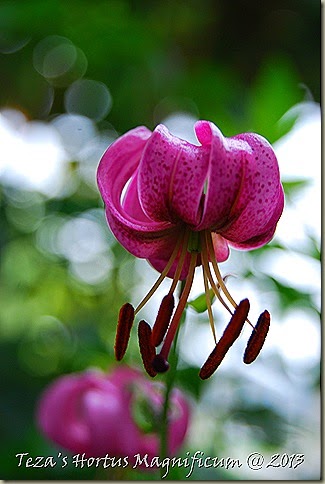

[Below is a page from the website homeovision.org on some of the mythology and legends surrounding this, one of my most favourite of plants.]
![DSC_0639_thumb[6] DSC_0639_thumb[6]](https://blogger.googleusercontent.com/img/b/R29vZ2xl/AVvXsEjGzTIzsJtlpawLGFWZZs0cKSxoMu3f35WdNVD35Y9sig1oHWvQNYYgPQgJ98HfV0RE9nBtXgnSnwyzSIQ-qBzoNM0_t8jJwJMQeWgbY07b_gBxE-i9rBWkq6QNWhKzXBUXCYYwwfK6DHqu/?imgmax=800)

Monkshood or Wolfsbane has a long history of association with witchcraft. Having proved too dangerously toxic for the legitimate pharmacy, it fell to the province of sorcerers & witches. It was a believed by many Christians to be a common ingredient in witches' potions, as is the case in Nathaniel Hawthorn's great tale of "Young Goodman Brown." Monkshoods are occasionally named "Love Poison" because it was used in love potions, forever the most popular thing witches (or any crone with a lifetime of herblore in her) was asked to concoct. If the proportions were gotten wrong, or if it was over used when not effective on the first couple doses, the object of the potion's effect merely died.
Mixed with belladonna, it was thought to induce hallucinations, & a widespread but improbable story is that covens of witches rubbed a concoction of monkshood & belladona all over their bodies in order to fly, or at least imagine they were flying. The toxin can in fact be absorbed through skin, & can at least caused elevated sense of extreme well-being. So whether or not it was actually used within sorcerous covens, there seems little doubt that, given the nature of the human beast, it was often regarded worth the risk of death merely to get stoned.
![Copy (2) of DSC_0206_thumb[7] Copy (2) of DSC_0206_thumb[7]](https://blogger.googleusercontent.com/img/b/R29vZ2xl/AVvXsEhF4gXSKvLuayHgU8qXK5SRP6eUrmaRTRaqamhbAfR-2Zt3snH8xR-a3POLTJVi6rcT6cWCu9AbxOJtcaf8QTVUhVdjrjh7nOWrI5wPpazULzRDmfed0JTPs-8gsXt4GFyvG-1hrBndQnaA/?imgmax=800)
In mythology, Monkshood was nefarious Medea's poison of choice. Ovid said she gathered it in Scythia, where it first grew from the slobber of three-headed Cerberus, the terrible dog that guards the gate to Tartarus. Pliny also tells the story of Hercules dragging the monstrous beast through its cavern to chain it to a pillar, & from its howling snapping jaws slavering froth flung out of cave giving rise to this plant in the mortal world. So when called "Dogbane," Cerberus the offspring of the Echidna is the dog meant.
![deadly beauty7_thumb[3] deadly beauty7_thumb[3]](https://blogger.googleusercontent.com/img/b/R29vZ2xl/AVvXsEjFO5dGcD4RbqODFz3y3n7pJ7bqoDt9-ID8TLYPVZ7-nyKFlVoOyTbIKcyohOK-9BjjjXbmVfU5eOIh8XlC71Z72yTWUNcY563uq2w4_zBXvr-zUG-ihaKyy-jgj7R9xODcwgvTfC7Z7tvB/?imgmax=800)
![DSC_0016_thumb[4] DSC_0016_thumb[4]](https://blogger.googleusercontent.com/img/b/R29vZ2xl/AVvXsEgYTvwZORL8sqdFO2yOwhl737fHjSm2CPTEdLHrsGcDozoEXZEVLYPlkWGHJOkcc7B7ywU9Nu5irEICJg9YDlQEy91x-72dmgwsepioNARTjJ12pcS09pzIQzKLGB77x7ievPglQLglWZAd/?imgmax=800)
![deadly beauties4_thumb[1] deadly beauties4_thumb[1]](https://blogger.googleusercontent.com/img/b/R29vZ2xl/AVvXsEiQYXeXCG-PYE0fb6IYDQqu2aUJhtZFfj1utZDj9n893AE9m3wZ0pAbXA-qpwiSIs4UxXCsMKC77cBA3PPr5NQxUPlMw8fTpFD1vpPHX-gciIrFMcJaAMQZM6u-FUvlv5uAaSbrQAptuzRQ/?imgmax=800)
![DSC_0626_thumb[3]_thumb[6] DSC_0626_thumb[3]_thumb[6]](https://blogger.googleusercontent.com/img/b/R29vZ2xl/AVvXsEi7inZH9VpluxIpGw0aQfU8CuDDVzl43MF0lStpGpNUuvyAz68rVA1XEYxYcKEsGwDwyAYqESRoNixAKR7wEWgKypyRZcR87aHShr60PEZKcJqzcPrpxYYAG9YQgsacJUiqLbDV9nUJRKvp/?imgmax=800)

































2 comments:
Those Greeks - such a fun loving bunch. Yours is proof positive that reading blogs is good for your mind. The monkshood you shared with me did beautifully this year. Whenever I see someone with one of those gorgeous late-blooming varieties, I kick myself that I didn't put one in earlier in the season.
Interesting Landscape Ontario event - will send you an email.
B.
artemesia
spiderwort and toad lilies
conjurers garden
a haiku for you :)
Post a Comment